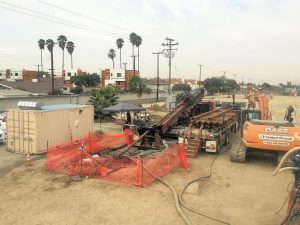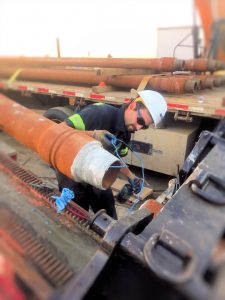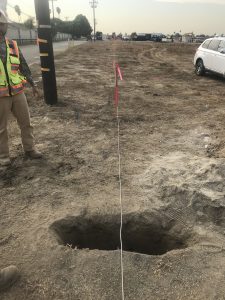Pilot Study Leads to 2nd Horizontal Remediation Well on SoCal Site
In 2014, DTD installed an 860 foot long horizontal biosparge well at a defense site in southern California. Inefficient remediation via vertical wells had allowed hydrocarbon-based contaminants (the usual BTEX but also MTBE and TBA) to persist in groundwater at the site. The 2014 horizontal sparge well was operated as a pilot study to determine the radius of influence (ROI) and level of cleanup that could be obtained. The horizontal well was installed at a depth of 45 feet, targeting a perched groundwater zone with upper and lower boundaries between 25 and 50 feet below ground surface.

DTD’s CMS 9030 rig and Knock-Off system were used to install the 733 foot biosparge well.
After two years of operation, testing, and monitoring using tracer and analytical testing of groundwater samples from adjacent monitoring wells, the wells have been shown to have a ROI of up to 45 feet. Additional dissolved oxygen levels show the well’s ROI may have reached as far as 90 feet, indicating excellent performance from a well with approximately 20 feet of submergence within the water bearing zone. This ROI extended the entire length of the horizontal screened section, showing good air distribution from the start to end of the well screen. The total area of treatment for this single horizontal well is upwards of 1.25 acres.
With the pilot program demonstrating encouraging remediation results, the next well in the system was designed to extend the treated area. Starting at the previous entry point, the second well extended in the opposite direction, with a design length of 715 feet. The target depth remained at 45 feet bgs.
The pilot well path traversed beneath surface infrastructure, including a small electrical power substation. Given proximity to large, high-pressure petroleum pipelines, an advanced navigation system was selected for the first well: a gyroscopic steering tool (GST). The GST uses inertial guidance to locate the drill bit in three dimensions as the bore advances. It also is immune to electrical interference and requires no surface walkover or wire coil, thereby allowing navigation with zero surface influence.

Making wireline connection for Sharewell Tru-Tracker navigation
For the second well, pinpoint accuracy was still required, due to proximity to additional buried pipelines. However, there were no significant surface obstructions, and no continuous sources of electrical interference were present. For this reason, a magnetic guidance system with a coil-based tracking supplement was selected for navigation. The navigation system, a Sharewell Tru-Tracker, provides accuracy similar to the GST system, at lower cost.
To set up for the Tru-Tracker, a wire coil is staked out to encircle the bore path and its location is precisely surveyed. In operation, the driller steers along a calculated geomagnetic azimuth, and at the end of each drill rod the coil is energized to provide an alternate method to confirm the bit location – this provides two data points for each survey shot, improving accuracy of the navigation.

Air knifing to 10-foot depth confirms safe passage of drill head past buried pipeline.
Pipeline regulations required that visual confirmation be made to assure the drill rods would pass beneath the pipeline, in addition to the tracking data that confirmed a 35 foot separation. Vacuum soil extraction was accomplished to excavate a small-diameter hole along the bore path and prior to its interception of the pipeline. With the Tru-Tracker confirming the depth at the target depth, visual confirmation that the bore was on track was not a surprise. At the distal end of the well, the bore was approximately six inches off the designed running line, and precisely at the design depth.
The bore was completed ahead of schedule, with drilling starting on a Tuesday afternoon and the well screen and casing installed by Friday. DTD used major components of our Knock Off system to protect the 4-inch PVC well screen and casing during installation to the full, design depth. Subsequent activities included well flushing and jetting, grouting of the surface seal, and installation of a protective vault and concrete apron.
The new well will be operated in combination with the pilot horizontal biosparge well, to continue the groundwater remedy at the site. In addition to these activities, tasks continue to clean up residual contamination in shallow soil at the site, with plans to eventually transfer the property to the local municipality to expand a park and green space at the site.